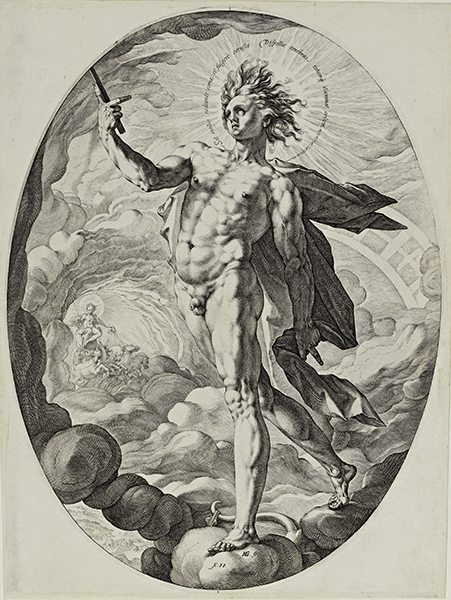The invention of printmaking in the 1400s led to an unprecedented proliferation of artistic imagery, which, by the sixteenth century, was transforming taste and culture throughout Europe.
Renaissance Impressions: Sixteenth-Century Master Prints from the Kirk Edward Long Collection offers a rich and comprehensive survey of the Golden Age of printmaking and reveals the vital impact of this new creative medium. It was through the printed image that the myths and motifs of Greco-Roman antiquity became widely known, fueling the classical revival that would define the age. Artistic innovation was also impelled by this new reproductive medium, which allowed the broad distribution of influential compositions by such towering figures as Michelangelo and Raphael, and spurred the spread of Mannerism as an international style. Through approximately 85 prints in varying techniques, this exhibition will explore the seminal role that prints played in shaping Renaissance visual culture across Europe.
The unique capacity of prints to affect dramatic cultural change was due to their visual intensity and intrinsic beauty. Renaissance Impressions features many of the era’s most extraordinary and influential prints, including examples in all graphic media from Europe’s major printmaking centers: Antwerp, Florence, Fontainebleau, Haarlem, Mantua, Paris, Prague, and Rome. Featured are compositions by the period’s greatest artists, among them Cranach, Dürer, Michelangelo, and Raphael, along with dazzling masterpieces that highlight the incomparable skill of the sixteenth-century’s printmakers. These include the ingenious Ugo da Carpi, master of the chiaroscuro woodcut; Mantuan Giorgio Ghisi, who transformed engraving in Northern Europe; the printmaking virtuoso Cornelis Cort; and Hendrik Goltzius, whose exemplary designs made him the most famous printmaker of the later sixteenth century. These compelling works also illuminate larger themes and trends including the spread of Mannerism from Italy to throughout Europe as the dominant sixteenth-century style and the impact of the Counter-Reformation on religious imagery in the latter half of the century.
As the “contemporary art” of the High Renaissance, print images proliferated and the market for both religious and secular imagery burgeoned. This led to the appearance of professional print publishers who offered audiences diverse subjects, from ancient myths like the Labors of Hercules to traditional Christian motifs such as the Rest on the Return from Egypt, while demanding ever-greater virtuosity from the printmakers. The painter Raphael was a key figure in the development of printmaking as both an art and a business. He collaborated with Marcantonio Raimondi, a Bolognese engraver, while a studio assistant, Baviero de’ Carocci served as production manager. Following Raphael’s death, Il Baviera continued to publish Raphael’s images in addition to commissioning new ones, establishing a business model refined by the Roman publishers Antonio Salamanca and Antonio Lafreri, and the Antwerp publisher Hieronymus Cock, who would dominate the publication and distribution of prints during much of the century.
Compelling imagery, imaginative design, and technical virtuosity were the qualities most prized by sixteenth-century connoisseurs, and artists throughout Europe met this aesthetic challenge whether they were treating novel themes associated with the revival of classical antiquity or traditional religious subjects. Over the course of the century, these artists produced graphic wonders that continue to fascinate today. Selected from the Kirk Edward Long Collection, perhaps the country’s most extensive private collection of sixteenth-century prints, Renaissance Impressions offers a rare opportunity to enjoy the masterworks that captivated Europe during the 1500s.
ITINERARY

Booking
For booking information, contact Michèle Wije at mwije@amfedarts.org or 212.988.7700 ext. 219.
Publication
The exhibition will be accompanied by a publication featuring a major essay by the guest curator contextualizing the Long Collection within the history of print collecting. The catalogue will also include essays by other contributors examining such subjects as the role of prints in propelling the new taste for classical antiquity; their contribution to the formation of Mannerism as an international style; and the role of Antonio Salamanca, Antonio Lafreri, Hieronymus Cock, and other print publishers.
Curator
Bernard Barryte, curator of the Kirk Edward Long Collection, was formerly Chief Curator and Curator of European Art at the Cantor Arts Center, Stanford University, from 1993 to 2016. At Stanford, Barryte curated numerous exhibitions including Chiaroscuro Woodcuts from 16th-Century Italy (2010); Rodin and America: Influence and Adaptation 1876–1936 (2011); Sympathy for the Devil: Satan, Sin, and the Underworld (2014); and Myth, Allegory, and Faith: Mannerist Prints from the Kirk Edward Long Collection (2015). Prior to joining the Cantor Arts Center, Barryte served as acting curator of Renaissance and Baroque art at the Walters Art Gallery, Baltimore, and as Curator of European Art at the Washington University Gallery of Art, St. Louis; the Joslyn Art Museum, Omaha; and the Memorial Art Gallery of the University of Rochester.
Credit
Organized by the American Federation of Arts.












